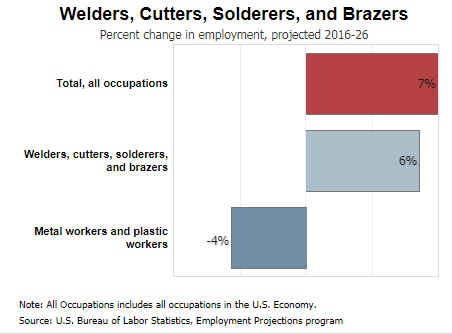Welder
| Quick Facts: Welders, Cutters, Solderers, and Brazers | |
|---|---|
| (US) 2017 Median Pay | $40,240 per year $19.36 per hour |
| Typical Entry-Level Education | High school diploma or equivalent |
| Work Experience in a Related Occupation | None |
| On-the-job Training | Moderate-term on-the-job training |
| (US) Number of Jobs, 2016 | 404,800 |
| (US) Job Outlook, 2016-26 | 6% (As fast as average) |
| (US) Employment Change, 2016-26 | 22,500 |
What Welders, Cutters, Solderers, and Brazers Do
Welders, cutters, solderers, and brazers use hand-held or remotely controlled equipment to join or cut metal parts. They also fill holes, indentations, or seams in metal products.
Work Environment
Welders, cutters, solderers, and brazers may work outdoors, often in inclement weather, or indoors, sometimes in a confined area. They may work on a scaffold, high off the ground, and they occasionally must lift heavy objects and work in awkward positions. Most work full time and overtime is common.
How to Become a Welder, Cutter, Solderer, or Brazer
A high school diploma or equivalent, combined with technical and on-the-job training, is typically required for anyone to become a welder, cutter, solderer, or brazer.
Pay
The median annual wage for welders, cutters, solderers, and brazers was $40,240 in May 2017.
Job Outlook
Employment of welders, cutters, solderers, and brazers is projected to grow 6 percent from 2016 to 2026, about as fast as the average for all occupations. The nation’s aging infrastructure will require the expertise of welders, cutters, solderers, and brazers to help rebuild bridges, highways, and buildings.

Duties
Welders, cutters, solderers, and brazers typically do the following:
- Study blueprints, sketches, or specifications
- Calculate the dimensions of parts to be welded
- Inspect structures or materials to be welded
- Ignite torches or start power supplies
- Monitor the welding process to avoid overheating
- Maintain equipment and machinery
Welding is the most common way of permanently joining metal parts. In this process, heat is applied to metal pieces, melting and fusing them to form a permanent bond. Because of its strength, welding is used in shipbuilding, automobile manufacturing and repair, aerospace applications, and thousands of other manufacturing activities. Welding also is used to join steel beams in the construction of buildings, bridges, and other structures and to join pipes in pipelines, power plants, and refineries.
Welders work in a wide variety of industries, from car racing to manufacturing. The work that welders do and the equipment they use vary with the industry. Arc welding, the most common type of welding today, uses electrical currents to create heat and bond metals together—but there are more than 100 different processes that a welder can use. The type of weld is usually determined by the types of metals being joined and the conditions under which the welding is to take place.
Cutters use heat to cut and trim metal objects to specific dimensions. Their work is closely related to that of welders. However, instead of joining metals, cutters use the heat from an electric arc, a stream of ionized gas called plasma, or burning gases to cut and trim metal objects to specific dimensions. Cutters also dismantle large objects, such as ships, railroad cars, automobiles, buildings, and aircraft. Some operate and monitor cutting machines similar to those used by welding machine operators.
Solderers and brazers also use heat to join two or more metal objects together. Soldering and brazing are similar, except that the temperature used to melt the filler metal is lower in soldering. Soldering uses metals with a melting point below 840 degrees Fahrenheit. Brazing uses metals with a higher melting point.
Soldering and brazing workers use molten metal to join two pieces of metal. However, the metal added during the soldering or brazing process has a melting point lower than that of the piece, so only the added metal is melted, not the piece. Therefore, these processes normally do not create distortions or weaknesses in the piece, as can occur with welding.
Soldering commonly is used to make electrical and electronic circuit boards, such as computer chips. Soldering workers tend to work with small pieces that must be positioned precisely.
Brazing often is used to connect cast iron and thinner metals that the higher temperatures of welding would warp. Brazing also can be used to apply coatings to parts in order to reduce wear and protect against corrosion.

Welders, cutters, solderers, and brazers held about 404,800 jobs in 2016. The largest employers of welders, cutters, solderers, and brazers were as follows:
| Manufacturing | 61% |
| Specialty trade contractors | 7 |
| Self-employed workers | 5 |
| Repair and maintenance | 4 |
| Merchant wholesalers, durable goods | 4 |
Welders and cutters may work outdoors, often in inclement weather, or indoors, sometimes in a confined area designed to contain sparks and glare. When working outdoors, they may work on a scaffold or platform high off the ground.
In addition, they may have to lift heavy objects and work in awkward positions while bending, stooping, or standing to work overhead.
Injuries and Illnesses
Welders, cutters, solderers, and brazers have one of the highest rates of injuries and illnesses of all occupations. They are often exposed to a number of hazards, including very hot materials and the intense light created by the arc. They wear safety shoes, heat-resistant gloves, goggles, masks with protective lenses, and other equipment to prevent burns and eye injuries and to protect them from falling objects.
The Occupational Safety and Health Administration (OSHA) requires that welders work in safely ventilated areas in order to avoid danger from inhaling gases and fine particles that can result from welding processes. However, they can minimize injuries if they follow safety procedures.
Work Schedules
Most welders, cutters, solderers, and brazers work full time, and overtime is common. Many manufacturing firms have two or three 8- to 12-hour shifts each day, allowing the firm to continue production around the clock if needed. As a result, welders, cutters, solderers, and brazers may work evenings and weekends.

A high school diploma or equivalent, combined with technical and on-the-job training, is typically required for anyone to become a welder, cutter, solderer, or brazer.
Education & Training
A high school diploma or equivalent, combined with technical and on-the-job training, is typically required for anyone to become a welder, cutter, solderer, or brazer. High school technical education courses and postsecondary institutions, such as vocational–technical institutes, community colleges, and private welding, soldering, and brazing schools offer formal technical training. In addition, the various branches of the U.S. Armed Forces operate welding and soldering schools.
Courses in blueprint reading, shop mathematics, mechanical drawing, physics, chemistry, and metallurgy are helpful.
An understanding of electricity also is helpful, and knowledge of computers is gaining importance as welding, soldering, and brazing machine operators become more responsible for programming robots and other computer-controlled machines.
Although numerous employers are willing to hire inexperienced entry-level workers and train them on the job, many prefer to hire workers who have been through training or credentialing programs. Even entry-level workers with formal technical training still receive several months of on-the-job training.
Licenses, Certifications, and Registrations
Courses leading to certification are offered at many welding schools. For example, the American Welding Society offers the Certified Welder designation.
Some welding positions require general certification in welding or certification in specific skills, such as Certified Welding Inspector and Certified Robotic Arc Welding.
The Institute for Printed Circuits offers certification and training in soldering. In industries such as aerospace and defense, which need highly skilled workers, many employers require these certifications. Certification can show mastery of lead-free soldering techniques, which are important to many employers.
Some employers pay the cost of training and testing for employees.
Important Qualities
Detail oriented. Welders, cutters, solderers, and brazers perform precision work, often with straight edges and minimal flaws. The ability to see details and characteristics of the joint and detect changes in molten metal flows requires good eyesight and attention to detail.
Manual dexterity. Welders, cutters, solderers, and brazers must have a steady hand to hold a torch in one place. Workers must also have good hand–eye coordination.
Physical stamina. The ability to endure long periods of standing and repetitious movements is important for welders, cutters, solderers, and brazers.
Physical strength. Welders, cutters, solderers, and brazers must be in good physical condition. They often must lift heavy pieces of metal and move welding or cutting equipment, and they sometimes bend, stoop, or reach while working.
Spatial-orientation skills. Welders, cutters, solderers, and brazers must read, understand, and interpret two- and three-dimensional diagrams in order to fit metal products correctly.
Technical skills. Welders, cutters, solderers, and brazers must operate manual or semiautomatic welding equipment to fuse metal segments.

Note: All Occupations includes all occupations in the U.S. Economy.
Source: U.S. Bureau of Labor Statistics, Occupational Employment Statistics
The median annual wage for welders, cutters, solderers, and brazers was $40,240 in May 2017. The median wage is the wage at which half the workers in an occupation earned more than that amount and half earned less. The lowest 10 percent earned less than $27,460, and the highest 10 percent earned more than $63,170.
In May 2017, the median annual wages for welders, cutters, solderers, and brazers in the top industries in which they worked were as follows:
| Specialty trade contractors | $43,020 |
| Repair and maintenance | 40,020 |
| Merchant wholesalers, durable goods | 38,930 |
| Manufacturing | 38,890 |
Wages for welders, cutters, solderers, and brazers vary with the worker’s experience and skill level, the industry, and the size of the company.
Most welders, cutters, solderers, and brazers work full time, and overtime is common. Many manufacturing firms have two or three 8- to 12-hour shifts each day, allowing the firm to continue production around the clock if needed. As a result, welders, cutters, solderers, and brazers may work evenings and weekends.

Note: All Occupations includes all occupations in the U.S. Economy.
Source: U.S. Bureau of Labor Statistics, Employment Projections program
Employment of welders, cutters, solderers, and brazers is projected to grow 6 percent from 2016 to 2026, about as fast as the average for all occupations.
Employment growth reflects the need for welders in manufacturing because of the importance and versatility of welding as a manufacturing process. The basic skills of welding are similar across industries, so welders can easily shift from one industry to another, depending on where they are needed most. For example, welders who are laid off in the automotive manufacturing industry may be able to find work in the oil and gas industry.
The nation’s aging infrastructure will require the expertise of welders, cutters, solderers, and brazers to help rebuild bridges, highways, and buildings. Also, the construction of new power generation facilities and, specifically, pipelines transporting natural gas and oil may result in new jobs.
Job Prospects
Overall job prospects will vary with the worker’s skill level. Job prospects should be good for welders trained in the latest technologies. However, welders who do not have up-to-date training may face strong competition for jobs.
For all welders, job prospects should be better for those willing to relocate.
Bureau of Labor Statistics, U.S. Department of Labor, Occupational Outlook Handbook, Welders, Cutters, Solderers, and Brazers, on the Internet at https://www.bls.gov/ooh/production/welders-cutters-solderers-and-brazers.htm (visited October 28, 2018).
Salary information comes from the Bureau of Labor Statistics, Occupational Employment Statistics Program, a semi-annual survey that provides wage and employment statistics for the nation, each state, and sub-state regions.
Tagged as Amarillo College, Apprentice, Brazing, Clarendon College, Frank Phillips College, Leland Fabrication, Panhandle, Production, Skye Leland, Soldering, Welder, Welding.
Written by Phillip












